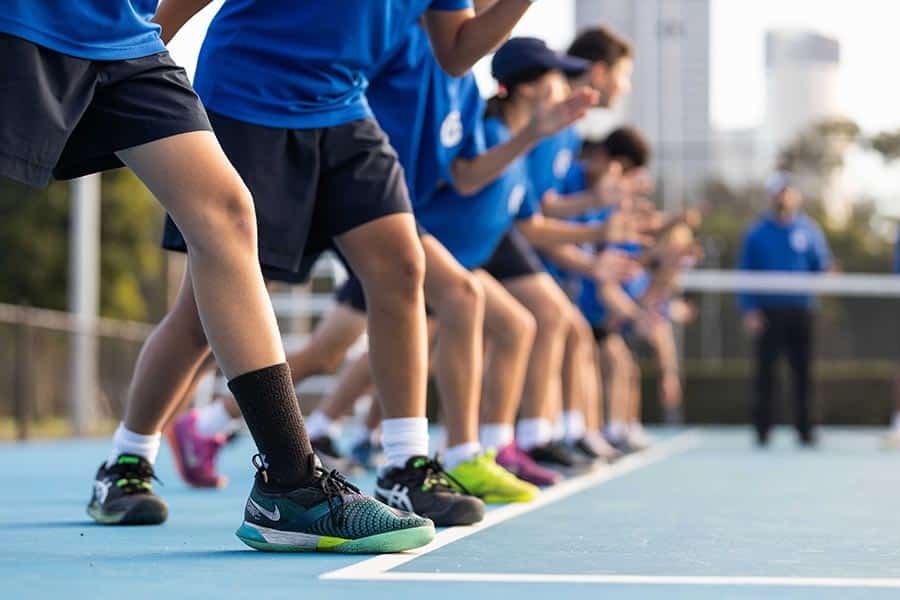
In any achievement in life, the higher the goal, the more commitment required. This certainly applies to tennis. Every player who reaches the highest level of the game has had to put in significant time on and off the court.
Less ambitious goals require lower levels of commitment, but commitment nonetheless. This article outlines training plans we recommend for players aspiring to different levels.
Hours on the court are the key to success
In 1993 Anders Ericsson developed the theory that it takes around 10,000 hours of deliberate practice to become world class in any field. His underlying message from over thirty years of research in this area is that talent doesn’t matter – purposeful practice does.
The book Bounce: The Myth of Talent and the Power of Practice by Matthew Syed compiles research across many areas of expertise, such as grand chess masters, athletes, musicians and artists, to understand what it takes to become world class in any field, sharing countless examples of top performers who seem to be gifted from an early age. This is actually often because they have been given extra tuition at home by their parents and have clocked up thousands of hours of practice. Examples include Tiger Woods who had hit thousands of golf balls before the age of two, Mozart who had done 3,500 hours of piano practice by the age of six, and Andre Agassi who was hitting one million balls per year as a junior.
While these examples may be extreme, the principle is that elite tennis players need thousands of quality hours on court to build up the fitness and skills to compete at a high level. Simply put, the more hours they put in on court, the better they will become.
Any parents looking to learn more on this subject, we’d strongly recommend you read Bounce, along with The Talent Code by Daniel Coyle and Outliers by Malcolm Gladwell.
Evidence from tennis players
Rather than provide recommendations based on guesswork or personal experiences, we conducted extensive research into how much time on court a player needs to reach the various levels of the game. We surveyed over 100 current and former players, from unranked to world number one juniors, right the way through to current and former professionals, to find out their training and match-play history up to the age of eighteen. The years leading up to eighteen are critical as players are choosing whether to take the college or professional pathway.
What we wanted to find out was:
- The player’s age
- How many hours’ training they did on court at each age, from starting right the way up to eighteen (if they were eighteen or older)
- How many matches they had competed in to that point
- Their playing level (ranking or rating) at that point
The findings were fascinating and remarkably consistent and are summarised below.
The more training hours and matches they took part in, the higher the player’s level. We didn’t see any exceptions to this rule. Every player who put a large amount of hours into training played matches at a significantly higher level than those who didn’t. There were also no examples of players who had put in significant hours on the court but didn’t have a correspondingly high playing level.
Playing a high volume of competitive matches was the strongest determinant of what level a player would be playing at (we will address match-play quantities in one of the coming articles). Players who only played a relatively small number of matches didn’t play at a high level, despite in some cases having a good training schedule.
Here are four real examples of twelve-year-old boys.
12/U world champion | 12/U top 3 Australian ranked | 12/U top 100 Australian ranked | 12/U unranked player |
Training hours per week, 42 weeks a year | Training hours per week, 42 weeks a year | Training hours per week, 42 weeks a year | Training hours per week, 42 weeks a year |
Age 3: hours p/week: 0 | Age 3: hours p/week: 0 | Age 3: hours p/week: 0 | Age 3: hours p/week: 0 |
Age 4: hours p/week: 0 | Age 4: hours p/week: 0 | Age 4: hours p/week: 0 | Age 4: hours p/week: 0 |
Age 5: hours p/week: 5 | Age 5: hours p/week: 3.5 | Age 5: hours p/week: 0 | Age 5: hours p/week: 0 |
Age 6: hours p/week: 10 | Age 6: hours p/week: 8 | Age 6: hours p/week: 0 | Age 6: hours p/week: 1 |
Age 7: hours p/week: 15 | Age 7: hours p/week: 9 | Age 7: hours p/week: 0 | Age 7: hours p/week: 1 |
Age 8: hours p/week: 15 | Age 8: hours p/week: 10 | Age 8: hours p/week: 1 | Age 8: hours p/week: 2 |
Age 9: hours p/week: 15 | Age 9: hours p/week: 11 | Age 9: hours p/week: 4 | Age 9: hours p/week: 2 |
Age 10: hours p/week: 15 | Age 10: hours p/week: 12 | Age 10: hours p/week: 6 | Age 10: hours p/week: 2.5 |
Age 11: hours p/week: 20 | Age 11: hours p/week: 12 | Age 11: hours p/week: 7 | Age 11: hours p/week: 2.5 |
Age 12: hours p/week: 20 | Age 12: hours p/week: 12 | Age 12: hours p/week: 8 | Age 12: hours p/week: 2.5 |
Total training hours 4,830 | Total training hours 3,255 | Total training hours 1,092 | Total training hours 567 |
+ 650 matches played (X 1.5 hours per match) | + 760 matches played (X 1.5 hours per match) | + 220 matches played (X 1.5 hours per match) | + 90 matches played (X 1.5 hours per match) |
Total hours on court 5,805 | Total hours on court 4,395 | Total hours on court 1,422 | Total hours on court 702 |
Approx. UTR 10.75 | Approx. UTR 9.6 | Approx. UTR 5.1 | Approx. UTR 3.6 |
Training volume
From the training history of the players we researched, here are the estimated number of training hours on court required to reach certain levels of the game. The hours per week are multiplied by forty-two as this is the average number of weeks that our students train per year. The remaining weeks are typically dedicated to tournament play or time off.
The most important column to pay attention to is the hours to date. From our research, this is the critical factor that determines how good a player becomes.
Training hours
Benchmarking male players | ||||||||
Levels | Level 1 | Level 2 | Level 3 | |||||
Age/Year at school | P/week | To date | P/week | To date | P/week | To date | |||||
Age 5 | 5 | 210 | 0 | 0 | 0 | 0 | ||
Age 6/Kindergarten | 6 | 462 | 4 | 168 | 0 | 0 | ||
Age 7/Year 1 | 7 | 756 | 5 | 378 | 4 | 168 | ||
Age 8/Year 2 | 8 | 1,092 | 6 | 630 | 5 | 378 | ||
Age 9/Year 3 | 9 | 1,470 | 7 | 924 | 6 | 630 | ||
Age 10/Year 4 | 10 | 1,890 | 8 | 1,260 | 7 | 924 | ||
Age 11/Year 5 | 11 | 2,352 | 9 | 1,638 | 7 | 1,218 | ||
Age 12/Year 6 | 12 | 2,856 | 10 | 2,058 | 8 | 1,554 | ||
Age 13/Year 7 | 13 | 3,402 | 11 | 2,520 | 8 | 1,890 | ||
Age 14/Year 8 | 14 | 3,990 | 12 | 3,024 | 8 | 2,226 | ||
Age 15/Year 9 | 14 | 4,578 | 12 | 3,528 | 9 | 2,604 | ||
Age 16/Year 10 | 15 | 5,208 | 12 | 4,032 | 9 | 2,982 | ||
Age 17/Year 11 | 16 | 5,880 | 13 | 4,578 | 10 | 3,402 | ||
Age 18/Year 12 | 16 | 6,552 | 14 | 5,166 | 10 | 3,822 | ||
Benchmarking female players | ||||||||
Levels | Level 1 | Level 2 | Level 3 | |||||
Age/Year at school | P/week | To date | P/week | To date | P/week | To date | |||||
Age 5 | 5 | 210 | 0 | 0 | 0 | 0 | ||
Age 6/Kindergarten | 6 | 462 | 3 | 126 | 0 | 0 | ||
Age 7/Year 1 | 7 | 756 | 4 | 294 | 2 | 84 | ||
Age 8/Year 2 | 8 | 1,092 | 5 | 504 | 3 | 210 | ||
Age 9/Year 3 | 9 | 1,470 | 6 | 756 | 4 | 378 | ||
Age 10/Year 4 | 10 | 1,890 | 7 | 1,050 | 5 | 588 | ||
Age 11/Year 5 | 11 | 2,352 | 8 | 1,386 | 6 | 840 | ||
Age 12/Year 6 | 12 | 2,856 | 8 | 1,722 | 6 | 1,092 | ||
Age 13/Year 7 | 13 | 3,402 | 9 | 2,100 | 7 | 1,386 | ||
Age 14/Year 8 | 14 | 3,990 | 10 | 2,520 | 8 | 1,722 | ||
Age 15/Year 9 | 14 | 4,578 | 11 | 2,982 | 8 | 2,058 | ||
Age 16/Year 10 | 15 | 5,208 | 12 | 3,486 | 9 | 2,436 | ||
Age 17/Year 11 | 15 | 5,838 | 13 | 4,032 | 10 | 2,856 | ||
Age 18/Year 12 | 16 | 6,510 | 14 | 4,620 | 10 | 3,276 | ||
Our research shows that female players who are pursuing college tennis need to do less than male players to achieve the same level. This is likely to be for two reasons:
- There are fewer females playing competitive tennis than males, so less competition.
- Female players have more US college scholarships available than male players, depending on what division of college tennis a player is competing at. Generally female players have eight full athletic scholarships per team while male players have 4.5 scholarships per team.
Hopefully this provides a good guide of how many training hours are required to achieve certain levels of the game for both male and female players.
In the next article we’ll go into detail about how to choose an appropriate training environment and developing a weekly training plan that will get results.
By Ryan Henry, Managing Director of Voyager Tennis and Ex-Pro Tennis Player




